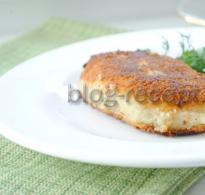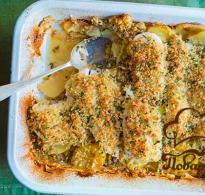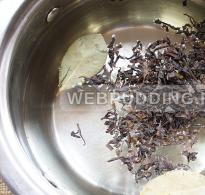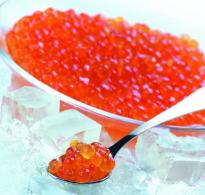Sponge cake with lemon cream. Sponge cake with lemon curd
*Note: This cake can be made without baking using ready-made sponge cakes. cakes (pack of 3 pieces). They are usually 24cm in diameter, so you will only need half the ingredients for the cream, the quantities below are based on a large sponge cake.
Ingredients for lemon cream:
- 8 eggs
- 450 g sugar (2 ¼ cups)
- 250 ml lemon juice (3-4 pieces)
- 3 - 4 tablespoons grated lemon zest
- 1 stick of butter (200 g)
- 1 liter of cream 30%
For decoration:
- 100 g white chocolate
- lemon slices
Preparing the biscuit:
Separate the whites from the yolks and beat them until stiff foam with a pinch of salt. Add sugar, vanilla, continue beating until sugar dissolves. Then add the yolks mashed with lemon juice.
Mix flour with baking powder and sift in small portions egg mixture, gently stirring it in with a spoon.
Pour the dough into a large rectangular pan. Bake at 180°C for 40 minutes. Leave for another 5 minutes with the oven door open. Remove from the oven, trim the edges of the pie with a knife if necessary. When completely cool (preferably the next day), cut into 3 equal pieces.
*Girls (and possible boys), it seems that a large rectangular shape means a “toast” measuring about 84 by 40 cm. I suspect that most of us do not have ovens of this size. Therefore, you need to somehow get out. Or, indeed, use ready-made cakes and half the ingredients for the cream, or bake three cake layers in turn, measuring approximately 28 by 40 cm (34 by 34, etc.), but kneading the dough for each separately so that it does not settle while the previous cake is baking. Well, or take the risk of baking one thick sponge cake, which is then cut into three thin ones.
Preparing lemon cream:
Boil the lemons in boiling water until a pleasant lemon aroma comes out of it (the water). Remove the lemons. After drying, rub lemon zest in the required volume and squeeze out the juice (separately from the zest).
Beat the eggs and sugar with a hand mixer at high speed. When the sugar dissolves, add a little lemon juice and continue whisking.
When the mixture thickens (after 10-15 minutes), add the zest to it, put on the fire and heat quickly, stirring, without bringing to a boil. Let cool slightly, add to the still warm mixture butter room temperature, cut into cubes, and stir until it is completely dissolved. Leave until completely cool.
Whip the chilled cream into thick cream, add the cooled mass and the remaining lemon juice, mix with a mixer at low speed or by hand.
Assembling the cake
Evenly spread a little more than a third of the cream over the bottom crust and place in the refrigerator. When the cake is slightly soaked, take it out, place the middle cake on top of the cream and press lightly with your hands. Spread the same amount of cream over it as over the bottom cake. Place in the refrigerator again. Place the top cake layer, press it again with your hands, and spread the remaining cream over it. Level the surface of the cream with a spatula. Place the cake in the refrigerator (preferably until the next morning).

Before serving, sprinkle with grated white chocolate and garnish with thin slices of lemon.
Delightful citrus taste: bitter lime, juicy large oranges, refreshing and invigorating lemons! All of them are not only tasty, but also incredibly healthy fruits for our body. They are the ones who vitaminize and thereby strengthen our immune system, preventing diseases from taking over. They lower blood cholesterol levels, preventing heart problems, improve carbohydrate metabolism, giving us strength and slimness, strengthen blood vessels, and promote digestion. There are many more reasons why you can respect and praise them.
What if all these qualities and flavors fit into one dish?! An explosion of vitamins in a different food form! In our world, nothing is impossible.
Meet Lemon Cake! Bright, in Spanish, extravagant in its choice of ingredients, sunny, uplifting - dessert. Every centimeter contains a sea of freshness, subtle notes of vigor.
Not only is this cake beautiful appearance: the taste rhapsody of citruses goes perfectly with butter cream, and frankly sounds in unison with the soft lush cakes. Not a big, but very important signature touch - the delicious lemon curd complements the idyll, which one is tempted to destroy by touching the beauty and tasting the dessert.
Ingredients
For the biscuit:
- Flour - 300 gr.
- Sugar - 250 gr.
- Butter - 150 gr.
- Eggs - 3 pcs.
- Baking powder - 10 gr.
- Salt - a pinch
- Vanilla extract - 1 tsp.
- Orange juice - 230 ml.
- Lemon zest - 1 tsp.
- Orange zest - 1 tsp.
- Lime zest (optional) - 1 tsp.
For the lemon curd:
- Eggs - 3 pcs.
- Sugar - 125 gr.
- Butter - 90 gr.
- Lemon juice - 90 gr.
- Lemon zest - 10 g.
- Corn starch - 5 gr.
- Salt - a pinch
Cooking method
Combine butter softened to room temperature in a deep container with sugar and beat using a mixer.

As a result, the mass should lighten and become airy. On average, this process takes 5-7 minutes, depending on the power of the mixer.
Start adding eggs to the creamy mixture, one at a time. Only after the previous one is well beaten add the next one.

Add to dough citrus zest and vanilla extract (can be replaced vanilla sugar and introduce at the initial stage, combining with regular granulated sugar).

Combine the sifted flour with baking powder and a pinch of salt. Add a third of this mixture. Mix well.

Pour in half the juice. Bring until smooth.

Add another third of the flour. After mixing, add the remaining juice.
Add the rest of the flour mixture. Mix well.

The lemonberry cake recipe involves baking each cake separately. From the specified volume of ingredients I got 3 cakes with a diameter of 20 cm.
Bake in a preheated oven at 160 degrees. Approximate time: 20 minutes (check with a toothpick for readiness).
Cooking Kurd. You can safely make it in advance and store it in glass jar in the refrigerator for about a week, or freezer up to half a year. It won’t be possible to store it for a long time, as it is very tasty and can be used with lightning speed. Can be used both as a layer and as a filling for cupcakes.
Mix eggs and sugar until smooth using a whisk. No need to beat, just mix.

Add chopped butter, zest, juice, starch and salt. Stir as much as possible and place in a water bath.

While the mass is in a water bath, it must be constantly stirred. First, the butter will melt and all the ingredients will come together. Continuing to stir our cream will become thick. After achieving desired consistency, remove the mass from the bath and transfer it to a cold bowl for quick cooling. Strain through a sieve.

Cover cling film into contact, set aside until completely cool. Then we transfer the lemon curd into a glass jar and put it in the refrigerator. Within a few hours it will be ready to use.

For the layering of this cake I used. In my opinion, it fits perfectly, adding extra tenderness to the dessert without overloading the taste. WITH detailed recipe This cream can be found at.
Let's move on to assembly. Cut off the tops of the cake layers so that the cake is even. Grease the first cake generously with cream. Place the second one on top and lubricate it lemon curd. Cover with a third one and also distribute the cream over the surface and sides of the cake.
You can decorate it however you like, there are no restrictions. Place the finished dessert in the refrigerator for 3 hours.

Recipe " lemon cake"Very attractive because it is quite simple to prepare! Adhering to cooking recommendations, using high-quality fresh ingredients, proportions, investing a little Have a good mood and imagination, you can cook cooking masterpiece. It will definitely please everyone who touches it. Will create the atmosphere of a southern sunny beach or a cozy home environment at the holiday.
Cooking instructions
2 hours 30 minutes Print
1. The amount of ingredients is indicated for 2 large cakes, each of which, after cooling, is cut crosswise into 2 parts. As a result, we will get 4 shortcakes. For one cake: take 4 eggs. Separate the whites from the yolks, beat the whites separately until stable peaks form, add sugar (half of 150 grams). Crib How to separate whites from yolks
2. Separately, beat the yolks with the remaining sugar and mix with the whites. Mix 150 g flour with 50 g starch and add half a teaspoon of soda. Add this mixture to the egg mixture and stir gently. Baking pan (I took springform) grease with oil and pour in the finished dough.
Place in an oven preheated to 170 degrees and bake for 20 minutes. Remove the cake from the mold. Cool and cut crosswise. Prepare the second cake using the same procedure.
Tool Oven thermometer
How the oven actually heats up, even if you set a specific temperature, can only be understood with experience. It is better to have a small thermometer on hand that is placed in the oven or simply hung on the grill. And it is better that it shows degrees Celsius and Fahrenheit simultaneously and accurately - like a Swiss watch. The thermometer is important when it is necessary to strictly observe temperature regime: say in the case of baking.
3. Lemon curd. Add lemon juice (100 ml), zest (1 tablespoon) and sugar (50 g) to the pan and bring to a boil. Gently beat 3 eggs and gradually add to lemon juice. Reduce heat and, stirring continuously, bring to a boil. Cook for about 5 minutes, stirring constantly, until thickened. Remove from heat. Pour into a deep container. Cover the top with something to prevent the curd from getting airy. Tool Manual press for citrus fruits Cup fresh juice or you can squeeze a lemon for cooking without resorting to bulky equipment. Manual citrus presses can handle this. According to the results of tests carried out in the editorial kitchen of the Afisha-Food magazine, the best of them was the Amco enameled juicer - as slightly old-fashioned in appearance and effective in practice as a large cast-iron press.
4. Lemon souffle. Add sugar (50 g) and eggs (2 pcs.) to starch (50 g), mix well! Boil milk in a saucepan. Pour hot milk into the egg-starch mixture in a thin stream, then pour everything back into the saucepan and cook over low heat until thickened. Remove the cream from the heat, transfer to a bowl, cover with film, and cool. Pour gelatin (30 g) with lemon juice (50 ml) and leave to swell. Then heat slightly to dissolve the gelatin. Pour juice with gelatin into custard and stir. Separately whip the cream and combine everything, add zest (1 tablespoon).
5. Assembly. We put our already cut cake back into the mold in which we baked the cakes. We grease it with lemon curd, pour in 1/4 of our mousse, put the next cake on top and repeat until the height of the walls of our mold is gone) you need to adjust it so that the last layer is the cake. If you have extra curd, mousse and shortcake left over, you can easily make another mini-cake out of them).
6. Place the cake in the refrigerator for 3-4 hours, I left it overnight. It was well soaked. And in the morning I quickly made the glaze.
7. Glaze: Melt chocolate with water in a saucepan, bring to homogeneous mass. Gelatin (30 g), soak in lemon juice (100 g) and allow to swell. While the gelatin is swelling, add condensed milk to the chocolate mixture. Mix everything, add the swollen gelatin. Mix. Remove from heat. Cool slightly. Remove the cake from the refrigerator and carefully remove it from the mold. I usually loosen the cake from the sides of the pan using a thin knife moistened with water. Using a knife with an oval nose, carefully coat the cake evenly on all sides with glaze.
Meringue cake with cream based on cream and lemon cream.
- 6 proteins
- 250 g powdered sugar
- 1 tbsp. l. natural vinegar 6% (or lemon juice)
- 1 tbsp. l. corn starch(without slide)
- a pinch of salt
- 300 g cream 30-36%
- 70 g pasty, soft, non-acidic cottage cheese (or mascarpone)
- 70 ml lemon juice + zest (1 lemon)
- 70 g sugar
- 30 g butter
- 3 yolks

Delicious cake, very light, airy, based on meringue cakes with a crispy top. Meringue cakes are cakes consisting of whipped egg whites and sugar, this cake is used in Pavlova cake, for example, the cake is very tender, airy, almost weightless. I deliberately do not call these meringue cakes, although they are often called that way, because when the word meringue is used, everyone associates it with completely dry and crispy, but meringue cakes are not like that, inside they remain soft, and they have a crunchy quality, like meringue. just a hat. I layered these wonderful cakes with whipped cream, lemon curd and a little cottage cheese. Cottage cheese is needed to make the cream a little thicker and more stable (so that it does not drip from the cakes). Mascarpone is also great for this purpose, but I understand that it is not accessible to everyone, both in terms of availability and price (you can also try using a thickener when whipping cream instead of adding cottage cheese).
Preparation:
We are preparing the cakes.
Separate the whites from the yolks.

Start gradually whipping them into an airy foam, then gradually adding powdered sugar, beat until stiff peaks form. Halfway through whisking, add salt and vinegar. The mass should become glossy, shiny and thick. I beat for 12 minutes, but the time can vary greatly depending on the type of mixer and its power, you may need more time, up to 20-25 minutes.
At the end of beating, add starch.

Line two baking sheets baking paper, on back side first draw two circles of 20 cm each and on the second one draw 1 circle of 20 cm (the easiest way is to circle suitable plate). In total we will have three cakes. If you do not have a second baking sheet or you are not confident in your oven, it is better to bake 2 cake layers on only one baking sheet (that is, divide the entire whipped mass into two cake layers).
Place a third of the mixture on each circle and smooth with a spatula.

Place in an oven preheated to 130 degrees and bake for about 1-2 hours. I dried it for almost 2 hours, switching the baking sheets halfway through baking. But you are guided strictly by your oven.
The cakes are light beige colour, and when tapped, crispy.
Cool the finished cakes completely.

Preparing lemon curd.
Remove the zest from the lemon by grating it on a fine grater (without touching the white layer).

Squeeze the juice out of the lemon itself (I got 70 ml).
Mix lemon zest, juice, yolks and sugar. Leave to stand for 10-20 minutes so that the zest releases its aroma.

Strain through a strainer into a small saucepan with a thick bottom and place on fire.

When the mixture is hot, add butter. Stirring all the time, continue cooking until thickened.

The mass can actively boil (this is clearly visible in the photo), but the eggs will not curdle, due to the fact that the composition contains a lot of acid.
Cool the finished curd completely.

Place 1-2 tablespoons of curd in a small tight bag, tie it and cut off a very small corner.

Preparing the cream.
Thoroughly blend the lemon curd and cottage cheese with a blender. Let me remind you that only homogeneous, paste-like and not sour cottage cheese is suitable here. Or you need to use mascarpone, or whip cream with a cream fixer.

Whip the cream to soft peaks.
500 g butter;
- 4 glasses of milk;
- 6 tbsp. l. semolina;
- 2.5-3 lemons (depending on size);
- ¼ tsp. vanillin or 2 tsp. vanilla sugar;
- 3 glasses of sugar.

For decoration:
100 ml. heavy cream;
- 200 g of chocolate (non-porous) for ganache + 100 g for decoration;
- 200 g marshmallow candies (chewable marshmallows);
- 200 g of powdered sugar;
- approximately 1 tbsp. l. odorless vegetable oil.

You need to start preparing the cake a day before the intended serving, in in this case this is done in the evening.
Lemon Buttercream Birthday Cake Recipe:
Preparing ganache
Start conveniently with preparation chocolate cream() to cover the cake before decorating with fondant. Pour the cream into a thick-bottomed saucepan and add the chocolate, put on low heat and stir the mixture until it becomes homogeneous.


Cool the ganache to room temperature and then put it in the refrigerator to cool.
For the cream you need to cook semolina porridge. It’s just as simple - pour semolina into boiling milk in a stream and cook, stirring, until thickened. Like ganache, let the porridge cool.

While the ingredients for decoration and cream are cooling, you can bake the cakes. You can already turn on the oven so that it warms up to 180-200 degrees.
Biscuit
Separate the yolks from the whites.

Using a mixer or whisk, beat the egg whites until stiff peaks form, then set aside.

Grind the butter with sugar, add the yolks, stir everything.



Add flour, starch and baking powder to the resulting mass, knead into a stiff dough.

Adding whipped whites to the stiff dough in parts, slowly knead the airy volumetric mass. Now the dough is ready.


Divide the dough into two parts, place one of the parts in a greased pan and bake for about 40 minutes. Then bake the second cake in the same way.


While the cakes are baking and cooling, you can continue preparing the cream. Wash the lemons thoroughly, grate completely coarse grater, remove the seeds from the grated lemons, and then finally grind them in a blender.


Lemon cream
Grind butter and sugar for cream.

Mix the crushed lemons with the cooled semolina porridge and vanilla, and then gradually stir in the sugar-butter mixture into the porridge. The cream is ready! Place it in the refrigerator for half an hour or in the freezer for 10 minutes.


Assembling the birthday cake
When both cakes have cooled, carefully cut them crosswise into two parts. Assemble the resulting four cake layers into a cake, coating big amount cream.


Remove the cooled ganache from the refrigerator and coat the cake with it (at least one third should remain). Naturally, the edges where the cream came out will flow. It’s okay, in this state, put the cake in the refrigerator overnight.


In the morning, smooth out the sloppy edges of the cake with a knife and coat with the remaining chocolate cream. Place the cake back in the refrigerator. The resulting chocolate layer around the cake will not allow the mastic, which needs to be applied on top, to spread from butter cream and evens out the surface of the cake.


Cake decoration
For mastic, chewing marshmallows need to be heated in the microwave for about 20 seconds. The marshmallows should not leak, but should become soft and stretchy.

Add almost all the powdered sugar to the warm marshmallows (reserve 2 tablespoons), and use a spoon and then knead into a ball with your hands. Sprinkle a smooth surface powdered sugar and start rolling out the mastic with a rolling pin.


To prevent the mastic from sticking and becoming elastic, lubricate it periodically when rolling out on both sides. vegetable oil. When the mastic layer becomes 1.5 times the diameter of the cake, carefully (you can use a rolling pin) transfer it to the cake.

Spread the mastic over the surface of the cake so that there are no folds and cut off any excess parts with a sharp knife. Roll the remaining mastic into a flagellum and place it on the bottom of the cake.


Melt about 100 g of chocolate in a water bath (put it in a cup placed over a saucepan of boiling water). Place the melted chocolate in a pastry syringe and draw random flowers, curls or congratulations to the hero of the occasion on the surface of the cake.



The festive cake is ready! Agree that it turns out very elegant, such a cake will become the main decoration of any table at any holiday, be it christening or New Year. Air sponge cakes are well soaked in an amazing cream with sourness, and no one will ever guess that the basis of all the deliciousness is banal semolina. If desired, next time the mastic can be tinted with food coloring.



Bon appetit!
Save to "Cookbook"





